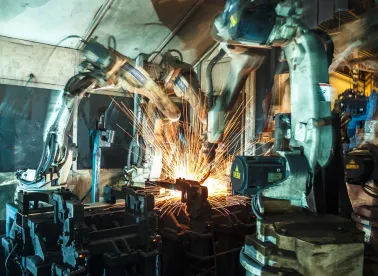2017 was a strong year for the automotive sector and related M&A activity, and we’re looking to generally continue that momentum in the year ahead. The new automotive ecosystem, in which traditional OEMs and automotive suppliers collaborate and integrate with established and emerging technology companies, continues to mature in many ways. Buyers across these sectors are leveraging strong balance sheets, relatively low borrowing costs and eager outside investors in order to participate in the race towards the development and full-scale market adoption of autonomous and connected vehicles.
Below are our top forecasts for 2018 that will affect the automotive M&A landscape:
-
Changes to NAFTA remain a possibility that could have adverse consequences for the automotive industry in North America. The United States, Canada and Mexico are continuing discussions to modify the agreement. U.S. officials have not indicated that they intend to withdraw from NAFTA, despite continuing disagreements among the parties.
-
Interest rates have ticked up slightly and additional modest increases are forecast as solid economic reports continue and unemployment rates continue to be low. Normally, rising interest rates can slow deal activity as buyers who typically rely on debt face higher borrowing costs and lower returns, which especially impacts financial buyers.
-
With the passage of the Tax Cuts and Jobs Act, there is a 20% deduction for pass-through entities like LLCs, and lower top rate will be welcome changes to dealmakers this year.
-
At a recent Original Equipment Suppliers Association conference, Chief Economist of General Motors G. Mustafa Mohatarem was optimistic about the global automotive industry, citing current U.S. economy strength and growth in China, the continued debt-crisis avoidance in the European Union and nearly ended recessions in Russia and Brazil. Mohatarem also cautioned that interest rate policies and the risk of future labor shortages in the industry are possible disruptors to the current U.S. production rate. The general consensus from the conference was that the next cyclical down cycle is out there, but panelists remained optimistic if not cautionary for the near term.
-
Trends in valuation multiples with automotive deals will remain strong. According to PricewaterhouseCoopers, EBITDA (earnings before interest, taxes, depreciation and amortization) multiples for the first half of 2017’s automotive deals generally ranged between five and 10, with those in the automotive electronics sector drawing up to 25. In contrast, PwC found deal multiples in the interiors sector averaging at five times EBITDA, due partly to automakers bringing work in-house. We predict these trends will continue and that valuations for underperforming sectors will stabilize or rise as buyers spot value opportunities and as technology continues to spread across the industry.
-
Automated, connected, electric and sharing (ACES) automotive technologies and business models will continue to be a top driver in M&A activity. Detroit OEMs and automotive suppliers have established Silicon Valley presences for access to technology, and many Silicon Valley technology companies are expanding to Detroit for automotive and manufacturing reasons. Large suppliers have accelerated their R&D activities by acquiring existing teams and technology companies are helping to drive deal activity and valuations higher.
-
The M&A activity for component suppliers has exploded due to auto-tech deals and we can expect this to continue. Large suppliers will continue to accelerate their R&D activities with ACES automotive technologies by acquiring existing teams, and traditional technology companies are becoming increasingly invested in this space and helping to drive deal activity and valuations higher and higher.
-
Lightweighting will continue to gain importance and bolster M&A activity. Albeit increased regulatory uncertainty in the U.S. and the Trump administration beginning to roll back the Obama administration’s CAFÉ targets, the rest of the world continues to adopt aggressive emission targets. Driver-assist sensors and infotainment features add weight to vehicles, and lightweighting materials will need to make up for that. The Center for Automotive Research indicates that by 2025, around five percent of the curb weight of the U.S. fleet will be added to every vehicle for these safety and performance improvements, including an additional 200-300 pounds per vehicle for automated driving features.
Although there are various technological, legal and consumer-driven hurdles on the horizon, demands and evolutions in each of these spaces should drive deal activity and valuations in 2018 and beyond. There may be disagreements about the realistic timeframe for achieving full (Level 5) vehicle autonomy, but there is a clear consensus that the journey may be lucrative for those who can keep up. Staying on the sidelines is not a long-term option.




 />i
/>i

